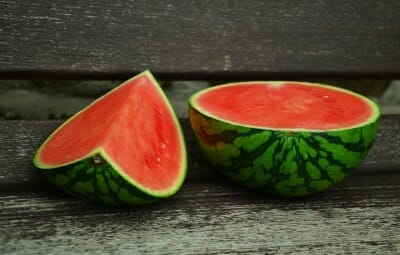How to Select The Best Watermelons
Is there anything better than sweet, juicy watermelon on a hot summer day? The only tricky part is picking a watermelon that has fully developed its sweetness without being over-ripe. The key thing to remember as you search for the best of the best is that ripeness occurs on a continuum – look for watermelons that fall in the middle of the pack for most of the following criteria. Those on either end of the continuum will likely be under-ripe or over-ripe. If nothing else, remember this:

Also Read: How to Cut Watermelon with and without Rind, Watermelon Granita, Watermelon Cucumber Feta Salad
What to look for when selecting a watermelon

1. Compare Overall Appearance
Look for a watermelon that is uniformly shaped and has good coloring compared to all the others around it. Because there are so many varieties of watermelons, it’s hard to advise “look for dark green, heavily striped melons” – it’s all about comparing one melon to another. Look at the general appearance of all the watermelons, look for those that are consistent with the norm. The one that is too shiny, too light or too dark compared to those around it is likely the one that’s over or under ripe. Oddly shaped melons may indicate that they didn’t get consistent water or sunlight – two things critical to sweet flavored melons.
2. Check the Field Spot

Large watermelons grow on the ground (some of the smaller varieties may be grown on trellises and never rest on the ground) and as a result develop creamy or yellow spots on the bottom where they sit on the field. These spots are a good indicator of ripeness as they become more yellow as the watermelon ages. You can see the various size and color of the field spots in the photo below. The two on the top are a light cream color while the bottom two are much more yellow. Choose the watermelon that has more yellow showing as it’s likely to be older and sweeter. But remember to compare it to the other watermelons around it – if it’s much yellower than all the other melons, it may be overripe.
3. Compare Weight
When you’ve narrowed your choice to two or three watermelons, pick each one up and compare their weight to the overall size of the melon. The one that’s heaviest for its size is likely to be the juiciest.
4. Do the Hollow Sound Test
You’ve probably seen people tapping or knocking on watermelons in the store. They’re looking for the watermelon that has a hollow sound when being tapped. Again, this test is pretty subjective and is only effective when comparing one watermelon to another. The best watermelon will have a slightly hollow, low pitch sound that resembles a drum or a knock on the door. The higher and flatter the sound, the least ripe the melon.
Video: Hollow Watermelon – sound test
Armed with these four techniques, you’re almost always guarantee a sweet, ripe watermelon.
How to Store Watermelon
Once you have your watermelon at home, here are a few other tidbits that might be helpful to know:
- Whole watermelons have a shelf life of 1-2 weeks. Keep in cool, dark space (not the fridge). The warmer the room temp, the shorter the shelf life.
- Once cut, store watermelon in the fridge. Either wrap cut edges with plastic wrap or store cubed melon in a sealed container. But only store cut watermelon for 2-3 days to prevent it from getting gritty.
Watermelon Tips
- Watermelons are 92% water, but that doesn’t mean they’re not also nutritious. Did you know watermelons contain Vitamin A, C and B6 and are also a good source of lycopene (anti-inflammatory), citruline (amino acid good for blood pressure) and electrolytes – potassium and magnesium. Read more from the Watermelon Board.
- Your average, 20lb seedless watermelon will produce 90 3/4 inch slices or 11 cups nicely cubed pieces with another 6 cups of juice and trimmings.

Now that we know how to buy and store the best watermelons, what shall we do with them?!



One Comment